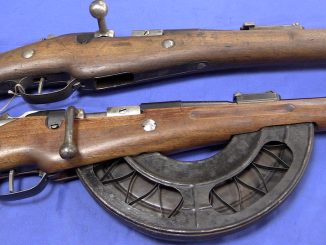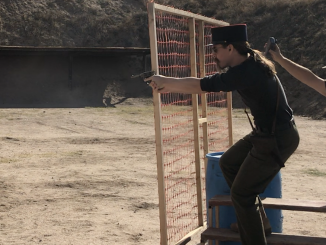In 1954, the Unique company (MAPF) in Hendaye France rebuilt a batch of 800 Berthier carbines into .22LR caliber for use by the Sûreté Nationale (later renamed the Police Nationale). These were to be used for training and also issued to prison guards. Both 1892 and 1916 pattern carbines were used, and so the CRS .22s can be found both with and without upper handguards. They were fitted with 5-round magazines from one of Unique’s pistols. The change of the firing system from centerfire to rimfire was rather cleverly done, with the new barrels bored at a slight angle to obviate the need to change the firing pin geometry. This did require shaving down the cocking piece and changing the sights, however.
Related Articles

Artillery
37mm Gun, Bethlehem, Semi-Automatic (Video)
The 37mm gun was found in many guises during World War One – that caliber was the smallest allowed to use exploding projectiles by the 1899 Hague accords. Every nation in the world, it seems, […]

Bolt Action Rifles
Berthier Carbine with Chauchat Magazine
Early in World War One, a small number (less than 200) Berthier rifle and cavalry carbines were adapted to use Chauchat magazines for aerial use. They were employed as defensive arms in observation balloons and […]

Competition
French Mle 1892 Revolver in Competition
Today at the Backup Gun Match, I’m shooting a French Modèle 1892 service revolver. It’s a 6-shot revolver with a swing-out cylinder, chambered for the 8x27mm cartridge (often called 8mm Lebel, although it really shouldn’t […]

I’m not an advocate of armchair quarterbacking, but would it not have been easier to simply install a concentric sleeve and design a new bolt head to accomodate the .22, seeing as a new bolt head was needed anyway?
I’m not at Ian’s level of expertise with French weapons, but I’ve come to the conclusion, based on looking over a lot of French designs, that the French arms industry often did things just to be contrary to everyone else. It’s like the involved engineers sat down in a meeting where someone said “Well, this is how the rest of the world would do it, so we’re going to have to come up with something else…”
The French arms industry seems to have “idiosyncratic” as a design goal, sometimes. You can almost visualize a group of the responsible parties standing around rubbing their hands in glee “Oh, this’ll get ’em…”
The French principle seems to be “good or bad, average is nothing”
—
I’ve got a French car ( I like it indeed ), but the cupholder at the driver’s side did puzzle me for quite some time until I by chance did find cups fitting it:
Those plastic, small cups used by the French when they are barbaric and do drink red wine from a plastic cup. This size cupholder for the driver …..
“Well, this is how the rest of the world would do it, so we’re going to have to come up with something else…”
This sounds like description of français for me. Like How does rest of Europe call that new calculating machine? Computer We will definitely call that ordinateur
But it is sooo French!
Interesting that the French decided to develop a .22 training rifle on the Berthier specifically to let the Police get effective low-cost practice with an understudy to the common issue rifle/carbine in the armories of various departments. Unusual to go to that level of training with rifles in police departments.
Many continental police organizations had their roots in quasi-military cavalry-ish bodies. Gendarme, Carabinieri etc. are distant from ‘constable,’ as concepts.
French Gendarmerie is still part of the armed forces just like the Italian Carabinierei or the Dutch Marechaussee (I probabaly spelled that one wrong) and not only act as normal police force, but also as the military police. Still very much a combat force at times as could be seen in Afghanistan or Iraq or other places they have been deployed to in recent decades. so keeping them proficient with the standard issue rifle makes sense.
I’m trying to work out how a barrel could be re- bored at an angle to the original bore?
I could turn an already bored and rifled barrel or liner to have the breech end eccentric, and press that into a bored out barrel
Then there’s the question of why the seperate bolt head wasn’t just fitted with an eccentric firing pin and a transfer bar at the back of it, and the rifle fitted with a normal concentric barrel.
For example of other rim-fire fire-arm derived from central-fire fire-arm via introduction of titled chamber see Наган Смирнского https://sites.google.com/site/russiannagant18951945/home/smirnskij-aleksandr-aleksandrovic
They could have done what the British with with some Martini, Enfield and rook rifle conversions; use the 22 Long Rifle Center Fire cartridge and avoid the whole issure of changing the firing pin and the off center bore.
I thought Ian touched on it; in order to not fritz w/ the sights too much, the bore is angled to the sights, rather then the sights being angled to the bore. Very French out of the box thinking.
Very, very cool! What a nice little plinker! The average American seems not to know about France’s tradition of engineering excellence.
Oh, we know. Trust me. There are reasons why Peugeot and all the rest don’t sell over here…
I have distinct and clear memories of my stepfather’s years running a foreign auto repair shop. We had one Peugeot 505 diesel towed in, and had the signal experience of trying to figure out how to break it to the owner that his wife had fried the engine by starting it up and trying to drive it while he was out getting oil for it in the middle of an oil change… The upshot was, the engine could possibly be salvaged, but the crankshaft would have to be replaced. Turns out, the best we could do on the price for said crankshaft was something like seven grand, just for the part. Engine rebuild would have been another few thousand in labor and incidental parts.
Routine, you say? Well, not really; due to some weirdly esoteric reasons about the way that crankshaft was machined, there wasn’t a machine shop in the entire western United States that would touch that sucker with a ten-foot pole. We tried finding someone in France to send it to (a mark of how much that client loved that car…) and the only French machine shop we could find who would talk to us basically said something like “Even we don’t bother with that… Junk the car; new parts are too expensive…”.
I’m not sure what the hell Peugeot did on that crankshaft, but whatever it was, it sure as hell wasn’t “industry standard” as understood by any machine shop we could find. We had a guy locally that machined stuff that people brought him from all over, including WWII Japanese military stuff for a guy doing restoration on it, and he was like “Yeah… Nope. Not touching that…”
I wish I could remember the exact details on that whole deal, but I’ve managed to lose everything past “French”, “weirdly machined crankshaft”, and “nobody would work on it”.
“(…)clear memories of my stepfather’s years running a foreign auto repair shop(…)”
So if you are discussing “France’s tradition of engineering excellence.” against “average American” did he used term De Dion axle for https://en.wikipedia.org/wiki/De_Dion_axle or it did that element got own U.S.-specific name. (For anyone not well-versed with history/France/19th century/automobiles name of said element is derived from French brand of De Dion, Bouton et Trépardoux active in late 19th century)
Kirk:
The Peugeot 504 was considered bombproof. It was popular across Africa because it was so strong. We had one as a loaner once and it was excellent. Can’t speak to the 505. Between my dad and I we have had a few French cars, a Simca 1100, Renault 16TS and sundry Peugeot 406s. Luckily we never had a crankshaft go. Dad sold the Renault to a friend’s daughter. She drove it with the oil warning light showing for about 80 miles and killed the engine, and the Simca got hit by another car at a roundabout and fell to pieces. Happy days.
I did not know of this conversion until watching this video. Be it that this was Post War, I wonder why the SN didn’t simply acquire the MAS 45, as I believe that the MAS 45 was put out in substantial enough numbers. Regardless, the Berthier conversion is pretty cool from a collectors stand point.